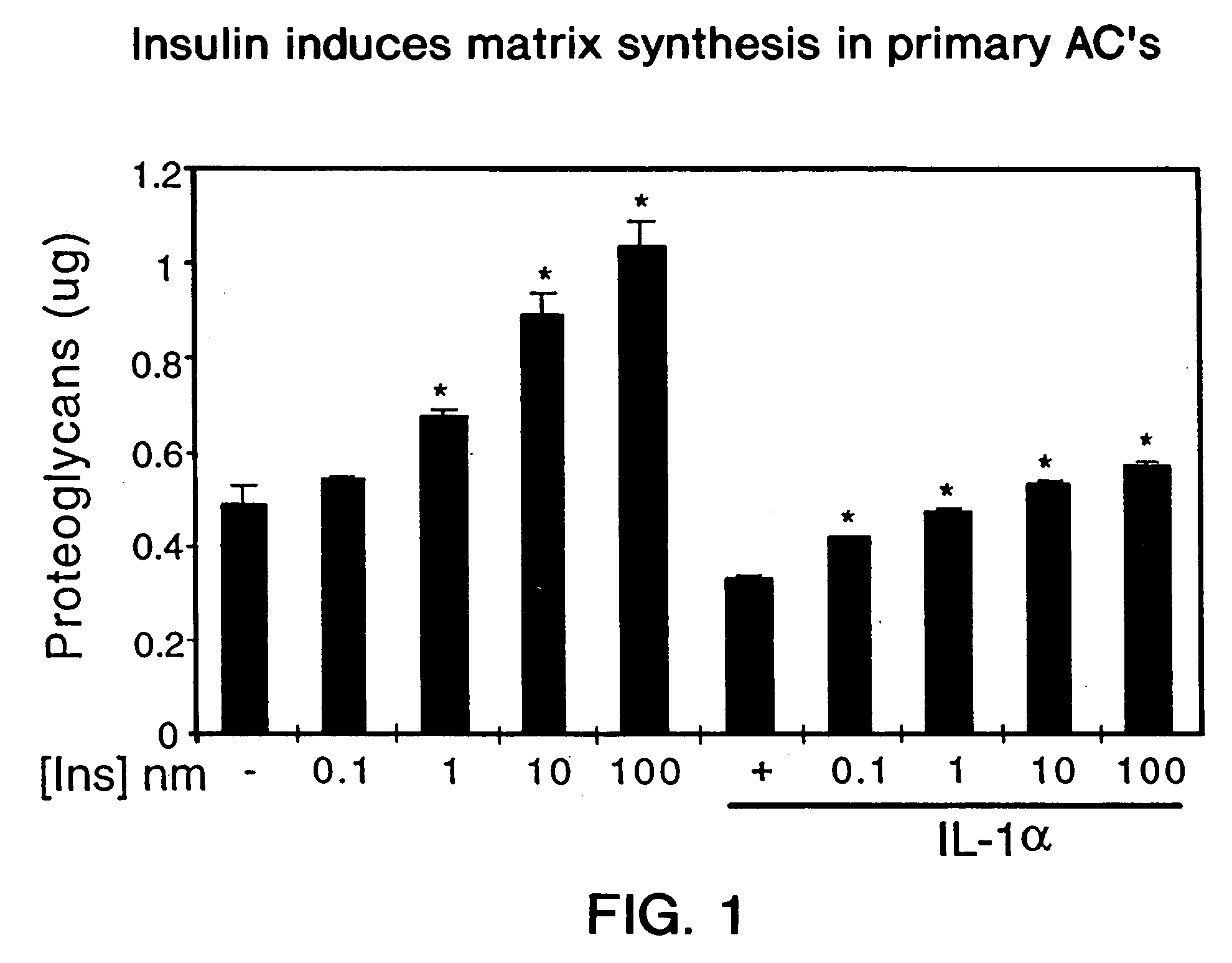Use of insulin for the treatment of cartilaginous disorders
a technology of cartilaginous disorders and insulin, which is applied in the direction of antimycotics, peptide/protein ingredients, depsipeptides, etc., to achieve the effects of preventing cartilage degradation, stimulating the regeneration or maintaining cartilage, and promoting the growth of chondrocytes
- Summary
- Abstract
- Description
- Claims
- Application Information
AI Technical Summary
Benefits of technology
Problems solved by technology
Method used
Image
Examples
example 1
Effect on Insulin on Primary Articular Chondrocytes
Introduction
[0327]This experiment shows the effect of various concentrations (0.1-100 nM) of insulin on matrix (proteoglycan) synthesis and on viability of chondrocytes in serum-free culture media. In order to culture chondrocytes, articular cartilage is digested with enzymes which remove the extracellular matrix. Thus, the cellular environment in this culture system may be similar to that found in later stages of cartilage disorders where the matrix has been depleted. Since essentially all of the matrix synthesized by chondrocytes cultured in monolayer is secreted into the media, the amount of proteoglycans in the media of such cells is indicative of matrix synthesis. Proteoglycans are measured in media using the 1,9-dimethylmethylene blue (DMMB) colorimetric assay of Farndale and Buttle, Biochim. Biophys. Acta 883: 173-177 (1986). In this assay, the change in color of the DMMB dye which occurs upon its binding to proteoglycans is ...
example 2
Articular Cartilage Explant Assay
Introduction
[0339]The experiments of this example examine both the synthetic and prophylactic potential of the test compound on cartilage matrix turnover. This potential is determined by measuring matrix (i.e proteoglycan) synthesis and breakdown, as well as nitric oxide production, in articular cartilage. These parameters are evaluated in the presence and absence of interleukin 1α, IL-1α. Articular cartilage explants have several advantages over primary cells in culture. First, and perhaps most importantly, cells in explants remain embedded in tissue architecture produced in vivo. Secondly, these explants are phenotypically stable for several weeks ex vivo, during which time they are able to maintain tissue homeostasis. Finally, unlike primary cells, explants can be used to measure matrix breakdown. To set up cartilage explants, articular cartilage must be dissected and minced which results in disruption of the collagen network and release of proteo...
example 3
Mouse Patellae Assay
Introduction
[0350]This assay determines the in vitro and in vivo effect of the tested compound on proteoglycan synthesis in the patellae of mice. The patella is a very useful model to study the effects of the test compound because it permits the evaluation on cartilage which has not been removed from the underlying bone. Moreover, since each animal has one patellae in each leg, experiments can be performed using the contralateral joint as a control. This assay involves injection of a protein into the intra-articular space of a (mouse) knee joint, and subsequent harvest (within a few days after injection) of the patella (kneecap) for measurement of matrix synthesis (FIG. 6). The procedure performed herein, and outlined in FIG. 6, has been previously used to measure effects of cytokines in vitro and in vivo (Van den Berg et al., Rheum. Int. 1: 165-9 (1982); Vershure P. J. et al., Ann. Rheum. Dis. 53: 455-460 (1994); and Van de Loo et al., Arthit. Rheum. 38: 164-172...
PUM
| Property | Measurement | Unit |
|---|---|---|
| pH | aaaaa | aaaaa |
| temperature | aaaaa | aaaaa |
| pH | aaaaa | aaaaa |
Abstract
Description
Claims
Application Information
 Login to View More
Login to View More - R&D
- Intellectual Property
- Life Sciences
- Materials
- Tech Scout
- Unparalleled Data Quality
- Higher Quality Content
- 60% Fewer Hallucinations
Browse by: Latest US Patents, China's latest patents, Technical Efficacy Thesaurus, Application Domain, Technology Topic, Popular Technical Reports.
© 2025 PatSnap. All rights reserved.Legal|Privacy policy|Modern Slavery Act Transparency Statement|Sitemap|About US| Contact US: help@patsnap.com



